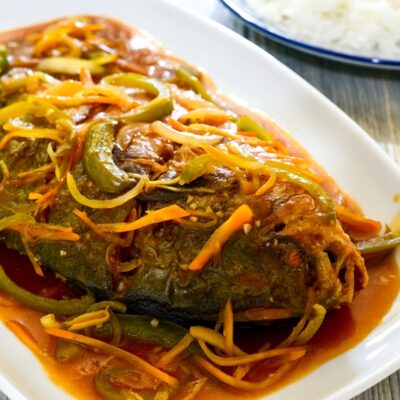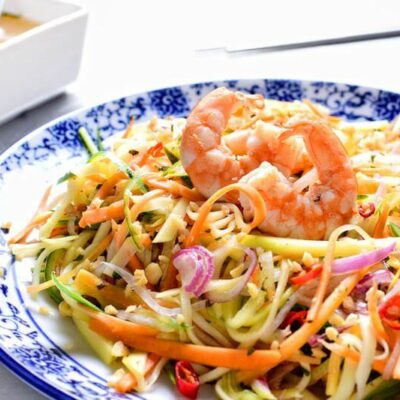
The popularity of shrimp knows no end. It’s the most frequently consumed type of seafood in the United States, which isn’t surprising given that shrimp tastes so good and is easy to find.
Most of us focus on cooked shrimp. This makes its way into many dishes, including some that can be prepared in the slow cooker. But, what about the alternative? Can you eat raw shrimp?
As with most raw seafood, the simple answer is that yes, you can eat uncooked shrimp, but doing so carries risks and could make you very sick. Such issues don’t mean you need to avoid raw shrimp entirely. A better goal is to be aware of the risks and complexities, and then decide for yourself.
P.S. Dried shrimp is raw too. The drying process should make it safer than regular dried shrimp, but some risks remain.
Can You Eat Raw Shrimp?

Raw shrimp isn’t just something you can eat. It’s actually considered a delicacy in many cultures, including Japan and Hong Kong, meaning that raw shrimp is highly sought after.
Yet, if you look online, there’s a host of opinions about raw shrimp. Some people say that you can eat it and reports of risks are overblown. Others say that raw shrimp is dangerous and should be avoided in all situations.
Part of the controversy comes from the fact that shrimp are bottom feeders. This increases the chance that the shrimp accumulate toxins and harmful bacteria from their environment, leading to increased risk.
Of particular concern is a bacteria called vibiro. Vibiro infections can present with food poisoning symptoms that pass within a few days or they can be more serious, potentially leading to sepsis. The risk of serious negative effects is higher for people with current health problems, such as liver disease or diabetes.
The size of the shrimp industry is worth considering too. Quality is often hard to track in large industries like this, so you often won’t know where your shrimp comes from or how it was stored before it reached you. Such issues are problematic enough with regular seafood. They’re an even bigger issue when you’re eating seafood raw.
What Happens If You Eat Raw Shrimp?
The impacts of raw shrimp vary. Many people eat shrimp regularly without any side effects at all. This is particularly true if the shrimp is fresh and has been stored well.
So, you might eat raw shrimp and be fine. Or, you might end up with food poisoning. Food poisoning is the reason to be cautious, as this can be severe and even life threatening.
Food poisoning often passes without the need for medical treatment. It’s not something to take lightly though, as a bout of food poisoning can be horrendous and may feel like you’re dying for 24 hours or more. A single such experience is enough to put some off raw seafood for life.
If you’ve eaten raw shrimp before without issue, doing so again mightn’t seem like a big deal. However, this doesn’t mean you’re always safe. Sometimes the shrimp you eat mightn’t have any harmful microbes. Or, perhaps your body fights them off without any serious negative effects.
The next time could be different. There’s also the chance that the risk of food poisoning from shrimp increases over time, as the climate changes and shrimp harvesting continues to be popular.
As such, it’s important to be careful, no matter how many times you’ve eaten raw shrimp previously.
What Are The Signs Of Food Poisoning?
Food poisoning presents with common illness symptoms, including fever, headaches, stomach pain, vomiting, and diarrhea. The intensity and duration of these symptoms vary between people and situations.
You might not recognize these symptoms as food poisoning at first, especially if they’re mild, but they’re still important to pay attention to.
Beyond this, food poisoning can sometimes impact your nervous system. This can present with symptoms like a headache, double vision, weakness, and tingling skin. These side effects are rarer and it’s worth consulting your doctor if you experience any of them.
Does Seafood Poisoning Go Away On Its Own?

Food poisoning does often get better on its own, without the need for medical intervention. You’ll normally just need to rest, stay hydrated, and perhaps increase your electrolyte intake.
If it’s difficult to keep anything down, try taking small sips of clear liquids, particularly those with electrolytes. This is crucial because vomiting and diarrhea mean that you’re often losing a considerable amount of liquid.
Some over-the-counter medications may also help, particularly those designed to treat diarrhea. Even with medication, food poisoning can lead to a horrible 12 to 24 hours. There isn’t much you can do except wait it out.
It’s important to talk to a doctor if your symptoms don’t improve or if you feel extremely unwell, especially if you have a compromised immune system. This matters because seafood poisoning doesn’t always move through on its own. It sometimes causes more serious issues and can even lead to death.
Who Shouldn’t Eat Raw Shrimp?
If you’re healthy, active, and eat well, raw shrimp doesn’t pose a giant risk. Even if you do get sick, your body will probably fight off any microbes. You might feel awful for a while, but that’s the extent of the problem (whether you want to risk a bout of serious food poisoning is a different question).
This isn’t the case for everyone. Pregnant women, people with a compromised immune system, children, and seniors should all be extremely cautious with raw seafood. Even undercooked seafood can pose a notable risk.
People in these groups are likely to see more serious effects from food poisoning, as their immune systems can’t easily fight off invaders. The symptoms of food poisoning could also aggravate other health conditions, potentially causing additional harm.
Plus, even if you’re healthy, there’s still the chance that seafood poisoning goes badly and even puts your health at risk. The risk is small, true, but it’s still there.
Can You Eat Frozen Shrimp Raw?
Despite what you might have heard, freezing food doesn’t kill microbes. The process does make them inactive, but they become active and start multiplying again once the food has thawed. This means that you can still get sick from frozen raw shrimp.
However, these shrimp tend to be frozen when they are caught and delivered to grocery stores without defrosting. This pattern makes the shrimp safer and reduces the risk of contamination.
All in all, the same pattern applies here as for non-frozen raw shrimp – you can eat them if you choose to, but there is a risk of food poisoning and perhaps severe negative outcomes.
How To Choose The Best Raw Shrimp

If you’re going to eat raw shrimp, it’s important to choose your shrimp carefully. In particular, make sure you know where the shrimp came from and how it has been stored.
This matters because raw shrimp has a very short shelf life, so much of the seemingly fresh shrimp you see in stores has actually been frozen and then thawed. This is an issue, as you mightn’t know where the shrimp originally came from and whether it has been at unsafe temperatures.
Whenever possible, look for sustainable wild caught shrimp. These tend to be the healthiest and best for the environment. Plus, companies that focus on sustainability also tend to be interested in maximizing quality rather than profits.
Finally, keep an eye out for any signs that the shrimp has gone bad, like sliminess or a bad smell. If you’re even a little unsure, it’s best to skip the shrimp, as it isn’t worth the risk.
How To Eat Raw Shrimp
The video below is an excellent illustration of how you can eat raw shrimp as-is, without any type of sauce or seasoning. In it, Tristan shows himself eating various parts of a raw shrimp, while talking about the flavor and texture every step of the way.
If eating raw shrimp on its own like this is too much, you could experiment with shrimp ceviche. Ceviche is in the middle of cooked and raw, as the acidic juices somewhat cook the shrimp, but only a degree. As a result, the shrimp isn’t as safe as fully cooked shrimp.
Raw Shrimp Vs Cooked Shrimp
The most apparent difference between raw and cooked shrimp is safety, as cooked shrimp is clearly much safer. Still… there are other differences to talk about as well.
The Flavor
Raw shrimp has a mild flavor complemented by a little sweetness and an ocean-like aftertaste. In contrast, cooked shrimp tends to have stronger savory flavors, plus some saltiness.
Shrimp will also brown during cooking, which adds to the complexity of flavor and makes the shrimp even more enjoyable.
Texture
Shrimp tends to become firmer and chewier when it is cooked. When raw, the shellfish is generally softer and more delicate. This texture difference is a big reason that many people eat raw shrimp regularly.
Nutritional Profile
The omega 3 fatty acid and protein content of shrimp doesn’t change much with cooking (raw shrimp do contain more protein and omega 3s per 100 grams, but that’s simply because of how shrimp lose water when they are cooked).
Some nutrients do decrease during cooking – an effect that varies depending on the cooking method. For example, some nutrients may leach into water if you boil the shrimp. Different nutrients may be lost if you grill the shrimp instead.
However, cooking also makes shrimp more digestible and increases the bioavailability of some nutrients. This means that raw shrimp and cooked shrimp are both nutritious, just in slightly different ways.
Types Of Shrimp

Shrimp are more variable than you might imagine. One area of difference is the size, where shrimp vary from tiny to colossal, with plenty of sizes in between. Terms for size aren’t consistent, so it’s important to check the count per pound instead. This will often be written as 31/40, meaning 31 to 40 shrimp per pound.
Beyond size, there are specific types of shrimp to consider, including the following:
- Pink Shrimp. These common shrimp are pink when they’re raw. They have sweet and tender flesh that tastes amazing when grilled.
- White Shrimp. These shrimp are both sweeter and nuttier than pink shrimp, but they can be used in the same dishes.
- Brown Shrimp. These shrimp have more minerality than pink or white shrimp and are often used in rich dishes like gumbo and curries.
- Tiger Shrimp. Tiger shrimp get their name by having striped black bands, which turn red when the shrimp is cooked. These are often large, which is helpful for making shrimp cocktails.
- Rock Shrimp. Rock shrimp have tough shells and a sweet flavor. They were once avoided because of these shells, but modern machinery can be used to remove them. As a result, the shrimp are generally sold with their shells removed.
- Mexican Blue Shrimp. These shrimp live up to their name and have a natural blue-gray color. They tend to be sweet and crisp, pairing well with acidic meals.
Prawns Vs Shrimp
The terms prawn and shrimp are often used interchangeably. That’s not surprising, as the shellfish themselves look similar and can be used in most of the same ways.
The biggest difference is where the shellfish live, as shrimps tend to be towards the bottom of the water, while prawns lay their eggs on rocks and plants and live higher in the water instead. Still, most of the time you’ll see the term prawns used for larger shellfish and shrimp for smaller ones, regardless of the actual species.
Frequently Asked Questions
How Do You Know If Shrimp Has Gone Bad?
The appearance of your shrimp is the first area to consider. Fresh shrimp should be somewhat glossy, where the flesh is flush with the shell of the shrimp. The eyes are typically bright and clear, while those of spoiled shrimp may be sunken or opaque.
Beyond this, pay attention to the smell of your shrimp and the way it feels. Slimy shrimp is never a good sign, and shrimp that smells bad should be thrown away immediately.
How Should You Store Raw Shrimp?
Raw shrimp should be kept in the coldest part of the fridge for as long as possible (or in the freezer if it is frozen). You might even keep the shrimp on a bed of ice, which helps maintain its quality. The shrimp won’t be good for more than two hours at room temperature, so be cautious about when you take it out of the fridge.
Is Frozen Shrimp Already Cooked?
Frozen shrimp is often cooked, but you can find raw frozen shrimp as well. The types are easy to differentiate, as raw shrimp are gray and transparent, while cooked shrimp are pink with red accents. Cooked shrimp is also less transparent and whiter. The packaging for your shrimp should also say whether it is raw or cooked.
How Long Does Raw Shrimp Last In The Fridge?
Raw shrimp doesn’t have a long shelf life. Even in the fridge, it will only remain good for one or two days. Cooked shrimp lasts three to four days. You’ll need to freeze your shrimp if you want it to last longer than that.
Is Shrimp Good For You?
Like most types of seafood, shrimp has many benefits. It’s packed with protein, omega-3 fatty acids, and nutrients. However, you still need to be cautious with the cholesterol content and the risk of food poisoning from raw shrimp.

















 How To Use Fresh Thyme
How To Use Fresh Thyme
Leave a Reply